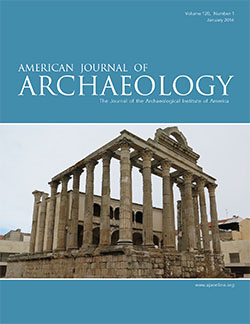AJA Open Access
BY-NCJanuary 2016 (120.1)
Book Review
The Land of the Elephant Kings: Space, Territory, and Ideology in the Seleucid Empire
By Paul J. Kosmin
Reviewed by Jan P. Stronk
In the field of ancient history, the Seleucid empire still ranks among the less-studied subjects, even though there is an increasing tendency in recent years to pay more attention to the Diadochi empires. The Seleucid empire (311–64 B.C.E.) was unlike anything the ancient Mediterranean and Near Eastern worlds had seen, with the exception of both the Achaemenid empire and that of Alexander the Great. Stretching from the area of present-day Bulgaria to Tajikistan—the bulk of Alexander the Great’s Asian conquests—the Seleucid kingdom encompassed, like the two referred to above, a territory of diversity (e.g., diversity in ethnicity, religion, and the languages that were spoken in it). In one major respect regarding the Seleucid kings’ ambition, though, they failed: they never succeeded to include Macedonia, the ancestral homeland of the dynasty, into their realm, even though they came close after Seleucus I’s victory over Lysimachus in 281 B.C.E.
In The Land of the Elephant Kings, Kosmin sets out to investigate how the Seleucid kings (called “Elephant Kings” because the Indian elephant was the dynastic blazon [3]), ruling over lands to which they ultimately had no historic claim or historic connection, attempted to transform this territory into a coherent and meaningful empire (for the full contents, see http://www.hup.harvard.edu/catalog.php?isbn=9780674728820&content=toc). In the process, Syria was adopted as the Seleucids’ new “homeland” (93–119), as the name “Seleucis” for northern Syria clearly testifies to. To fulfill their purpose, the Seleucids had to create a state that was both unified in imperial ideology and articulated by spatial practices. Kosmin points out that Seleucid geographers and ethnographers worked to naturalize the kingdom’s borders with India (31–58) and Central Asia (59–76) in such an appealing manner that it strongly influenced both Roman and later medieval understandings of “the East.” By mapping the Seleucid kings’ travels and studying the cities they founded—an ambitious colonial policy, a legacy of Alexander the Great, which has influenced the Near East to this day—Kosmin shows how the empire’s territorial identity was constructed on the ground: it is the main subject of parts 3 and 4 of this book. As it is, Kosmin’s maps (184–85) clearly show that the colonies were mostly situated in two clusters or “colonial panels” (186–92)—in northern Syria and the Tigris Valley. That same colonial policy also had a drawback: it functioned relatively well under the condition of a strong central power, but in the empire’s final century, when enemies pressed the borders harder and central power was disintegrating (certainly after the so-called Treaty of Apamea, concluded between the Roman republic and King Antiochus III in 188 B.C.E.), the very forces that had created the Seleucid territory also contributed to its demise.
Reviewing Kosmin’s attempt to outline the vicissitudes of the Seleucid empire, I am mostly pleased. Kosmin has written an accessible and generally well-documented work that offers its readers ample value for their money. As for cited works, Kosmin especially excels in his treatment of Greek sources. Noteworthy is his discussion of Megasthenes’ Indica in the appendix (261–71), in which Kosmin favors the traditional date (i.e., under the reign of Seleucus I), instead of Bosworth’s revised date of 320–318 B.C.E. (A.B. Bosworth, “The Historical Setting of Megasthenes’ Indica,” CP 91 [1996] 113–27). Nevertheless, some criticism is possible. The main criticism is that the interpretation by Kosmin of Babylonian sources is somewhat overenthusiastic and guided by unwarranted parallels (e.g., settlers in California from Japan and Punjab or immigration to New York by Chassidic Jews [108–10]) rather than by the texts themselves. I also found Kosmin too negligent in his treatment of Patrocles’ periplus of the Caspian Sea, especially in terms of the implications of this work for the Seleucids’ territorial claims, much like Scylax had done centuries earlier for Darius I the Great with the Indus River, the Persian Gulf, and “the Ocean” (68–76). Such a fundamental stone in both Seleucid imperial ambition and ideology deserves a fuller treatment than Kosmin provides in this book. Kosmin rightly stresses the lack of sources for royal traveling outside the axes of Babylon-Sardis and Babylon Gaza (e.g., 157–69). On page 164, Kosmin refers to the Seleucids’ Persian predecessors and the function of their travels: as yet he fails to adduce in this context the evidence that the Persepolis Fortification Archive provides of the Achaemenid kings’ travels in their empire. These are, though, essentially minor points of criticism in comparison with the assets the book has to offer. I believe Kosmin provides above all a welcome trait d’union between the (scale of the) world as seen by students used to the familiar perception of ancient Greece and that of those studying Achaemenid history. Also as such, it is a useful and bright introduction to Seleucid ideology, history, and position in the ancient world.
In that perspective, I find it extremely cumbersome that the notes in this book (273–360) are offered as endnotes instead of footnotes (irrelevant whether it is the publisher’s policy or the author’s choice). In my view, endnotes generally are less convenient to handle, they disrespect the reader’s ambition for a quick view to a specific reference, and above all they distract from the unity between text and note. In works like the one under scrutiny, the argument that endnotes make the book easier to read for a general public is irrelevant: in the end it is intended as a textbook for a (more or less broad) academic audience, not as a novel. Academic use should have, therefore, precedence. A useful glossary (361–67), excellent bibliography (called “references” [369–405]), and a general index (409–23) conclude this book. A separate index of sources is regrettably absent. The book is nicely produced and well edited with few typos.
Jan P. Stronk
Ancient History
University of Amsterdam
j.p.stronk@uva.nl
